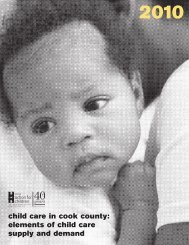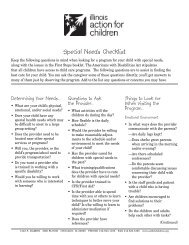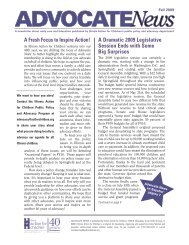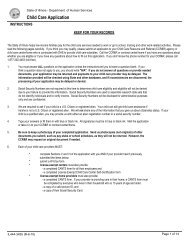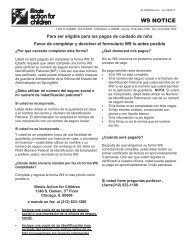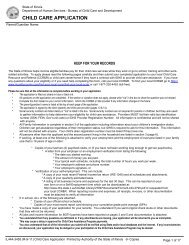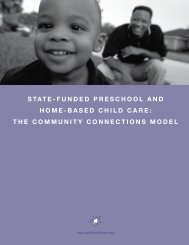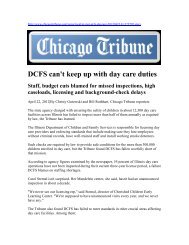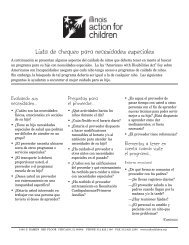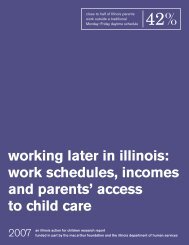AFC Policy Platform - Illinois Action for Children
AFC Policy Platform - Illinois Action for Children
AFC Policy Platform - Illinois Action for Children
- No tags were found...
You also want an ePaper? Increase the reach of your titles
YUMPU automatically turns print PDFs into web optimized ePapers that Google loves.
we believe that goodpublic policy must bein<strong>for</strong>med and shaped bythose directly affected.
Dear Friend<strong>Action</strong> <strong>for</strong> <strong>Children</strong> began in 1969 as theDay Care Crisis Council, and wasmost recently known as the Day Care<strong>Action</strong> Council of <strong>Illinois</strong>. From itsorigin, the agency advocated <strong>for</strong> qualityimprovements in child care centers, andsupported the growing numbers of womenentering the work<strong>for</strong>ce.35 years later, while many things havechanged, our commitment to accessiblehigh quality child care and early educationhas not. As <strong>Action</strong> <strong>for</strong> <strong>Children</strong>, webelieve that good public policy must bein<strong>for</strong>med and shaped by those directlyaffected. This first means working withparents and child care professionals toarrive at our positions. Then we worktogether to educate and in<strong>for</strong>m law andpolicy makers to make a difference inthe lives of families and their children.And we are making a difference. Today,<strong>Action</strong> <strong>for</strong> <strong>Children</strong> has grassrootsmembers in every <strong>Illinois</strong> state senatedistrict. Our members are committedand most importantly, they areeffective. We have celebrated manyaccomplishments including:• Passing HB294 which updated incomeeligibility <strong>for</strong> the IDHS Child CareAssistance program to 50% of thecurrent State Median Income (SMI) andsecuring funding to pay <strong>for</strong> the increase;• Maintaining the child care budget ata time when it was facing $60 millionin cuts;• Registering and encouraging thousandsof parents and others who care aboutchildren and families to vote; and• Creating the Great START program toprovide direct salary enhancementsto child care professionals based oneducation and training in the field ofEarly Care and Education.While significant, these victories areonly the beginning of our work. Workingfamilies still struggle to find high quality,accessible and af<strong>for</strong>dable care <strong>for</strong> theirchildren, and the early care and educationprofession suffers from a lack of resourcesnecessary to raise quality.The pages that follow outline ourstatewide policy agenda that will addressthese issues. We urge you to read thisbooklet, contact us <strong>for</strong> more in<strong>for</strong>mation,and most importantly, join or renew yourmembership to <strong>Action</strong> <strong>for</strong> <strong>Children</strong> andpartner with us in this important work.Best wishes,Maria WhelanPresident / CEOSessy NymanVice president, Public <strong>Policy</strong> andGovernment Relations
Creating a Universal Early LearningSystem <strong>for</strong> All Families Who Choose It<strong>Illinois</strong> is at a critical juncture in itsef<strong>for</strong>ts to create a strong system of earlylearning <strong>for</strong> all children. There is no doubtthat progress has been steady and significantaccomplishments have been achieved.However, there is much more work to bedone to ensure that the most vulnerablefamilies and children reap the full benefitsof programs that support both family selfsufficiencyand high quality preschool education.<strong>Action</strong> <strong>for</strong> <strong>Children</strong> believes in creating avoluntary system of “universal preschool”that is accessible to all families whochoose it. This system must be built uponthe current delivery systems of child care,Head Start and Pre-Kindergarten—thestrengths of which should be maintained,while administrative barriers preventingeffective collaboration are broken down.This system must also support the needsof working families and respect theirchoices with regard to the type of carethey choose <strong>for</strong> their children. Finally,“universal preschool” must include childrenages birth to three in order to build acomprehensive voluntary system of carethat prepares young children to enterschool ready to succeed. Given <strong>Illinois</strong>’diversity, no one approach will work inall communities, there<strong>for</strong>e local inputand flexibility is essential to the successof any plan.Talk of “universal preschool” has beenbuilding in <strong>Illinois</strong> <strong>for</strong> several years,and <strong>Action</strong> <strong>for</strong> <strong>Children</strong> has always beenat the <strong>for</strong>efront of these conversations.Most recently, <strong>Action</strong> <strong>for</strong> <strong>Children</strong>, alongwith other advocacy groups, advocated <strong>for</strong>creating the Early Learning Council.Signed into law by Governor Blagojevichin July of 2003, the Council’s goal is todevelop a statewide system of high qualityearly learning, serving children age fiveand younger. The Council will report itsrecommendations to the Governor andGeneral Assembly annually. <strong>Action</strong> <strong>for</strong><strong>Children</strong> is proud to be both an appointedmember of the Early Learning Counciland a key partner in two campaignsworking to strengthen early learning:Chicago Partners <strong>for</strong> <strong>Children</strong> and EarlyLearning <strong>Illinois</strong>.We are working to improve service coordinationand collaboration between HeadStart, child care and Pre-K, as well as:• Identifying service gaps and barriersto early care and education <strong>for</strong> familiesin Chicago;• Developing and testing new collaborativemodels <strong>for</strong> providing high quality,educationally enriched child care thatmeets families’ needs; and• Providing education and securing publicsupport, as well as political commitment,<strong>for</strong> early learning across the state.The policy statements in this publicationwork not only to strengthen the child careprofession and support working families,but also to lay a strong foundation <strong>for</strong>universal access to preschool in <strong>Illinois</strong>.
To provide the best outcomes <strong>for</strong> childrenand the best options <strong>for</strong> parents, <strong>Action</strong> <strong>for</strong><strong>Children</strong> will:• Advocate <strong>for</strong> increased investment inchild care to secure its infrastructure;• Support increased professionaldevelopment opportunities <strong>for</strong> child careprofessionals; and• Promote quality in child care settings.Child care is the cornerstone of auniversal preschool system in <strong>Illinois</strong>,serving an estimated 200,000 childrenin 2004 through the state’s Child CareAssistance program. <strong>Action</strong> <strong>for</strong> <strong>Children</strong>will work to ensure that children andworking families come first as the systemis designed and implemented.
Increasing and Expanding the EarlyChildhood Block GrantToo many children at risk of academicfailure lack access to high quality earlyeducation. In addition to serving childrenages 3-5, <strong>Illinois</strong> needs to equallyprioritize the needs of children birth tothree through a variety of prevention,education and parental support initiatives.BackgroundThe Early Childhood Block Grant (ECBG),which is administered by the <strong>Illinois</strong> StateBoard of Education (ISBE), is a collectionof grants that fund programs to serveyoung children. The Pre-Kindergartenprogram <strong>for</strong> children at risk of academicfailure (Pre-K) is the largest, servingnearly 56,000 three- and four-year olds inFY 2003. Other programs funded by theECBG focus on children ages birth tothree and include parental training andprevention initiatives.During his campaign, Governor Blagojevichpledged to expand early education servicesto an additional 25,000 children deemedat-risk of academic failure. He took steps tofulfill this promise in FY04 by expandingthe ECBG by almost $30 million. Thismoney, the first of a 3-year pledge, willserve an additional 8,000 children.The program’s reach has been expanded inother ways, too. Previously, only schooldistricts could apply <strong>for</strong> Pre-K funding.This year community-based organizationscan apply directly <strong>for</strong> funding.In FY04, several community-basedprograms applied <strong>for</strong>, and were granted,funding by ISBE. Of the new programsfunded through the increase in the ECBG,over 70% were community based. Theseinclude 19 prevention initiatives, 24 Pre-Kand 1 parental training program. Inaddition, Chicago Public Schools receive37.1% of the ECBG funding ($11.1million of the increased funds in FY04) todistribute directly to programs within thecity of Chicago.<strong>Action</strong><strong>Action</strong> <strong>for</strong> <strong>Children</strong> supports the Governor’scommitment to increase the EarlyChildhood Block Grant, supporting childrendeemed at-risk of academic failure. It iscritical that child care and other community-basedorganizations be stewards ofthis money in order to meet the needs ofworking families. <strong>Action</strong> <strong>for</strong> <strong>Children</strong> willwork to offer the technical assistance andresources necessary to apply <strong>for</strong> ECBGfunding. Blending ECBG programs withchild care is central to ensuring a systemof universal access to preschool <strong>for</strong> all<strong>Illinois</strong> children. Furthermore, ef<strong>for</strong>tsmust be made and models developed toensure that all child care, includinglicensed family child care and licenseexempt child care, are included in thatsystem. Without their participation,<strong>Illinois</strong> will never truly reach “universal”status in our goal to provide voluntaryaccess to preschool <strong>for</strong> all families.
Low-income families payup to 14% of their grossfamily income in childcare co-payments—twice as much as theaverage American familypays <strong>for</strong> child care.
Lowering Child Care Co-payments<strong>for</strong> ParentsBackgroundEvery family that receives child careassistance from the <strong>Illinois</strong> Department ofHuman Services (IDHS) is required tocontribute a co-payment toward the cost ofthe child care services they receive. In1997, IDHS implemented the existingsystem that uses a sliding fee scale basedon family income, size and number ofchildren in care to determine co-paymentamounts. Un<strong>for</strong>tunately, the amounts setby the current fee scale are so high thatquality child care is unaf<strong>for</strong>dable <strong>for</strong> manylow-income families.While the current system requires asignificant co-payment from families at orbelow the federal poverty level (FPL),co-payments increase steeply <strong>for</strong> familiesabove the FPL. Families at the top ofthe income eligibility scale can beassigned a co-payment equal to 14% oftheir gross income—twice the amountthe average American family pays <strong>for</strong>child care.The current co-payment system alsodiscourages families living in poverty fromenrolling their children in Head Start, aprogram created specifically to enhancethe school readiness of children in poverty.Although no co-pay is required toparticipate in part-day Head Start,programs that blend funding to offer fulldaychild care services (in order to meetworking parents’ needs) must chargefamilies living in poverty a hefty co-payment.Families that can’t af<strong>for</strong>d requiredco-payments may have no choice butto place their children in lower-quality,unregulated care.Because the state’s reimbursement rate toproviders is so low (see: Increasing BaseReimbursement Rates <strong>for</strong> Providers), manyhigh-quality child care programs requireparents to pay the difference betweenthe reimbursement rate and their “privatepay” rate, creating additional costs <strong>for</strong>struggling families.These flaws in the system discourageenrollment in high-quality child careprograms, particularly by low-incomechildren who are in need of the qualityearly learning that such programs offer.ResearchPrior to 1997, families in <strong>Illinois</strong> withincome at or below the FPL paid a tokenamount of $1 per month. Under thecurrent co-pay scale, deeply impoverishedfamilies at 50% of the federal povertylevel, with two children in care, pay $30per month. Families at the FPL ($15,260<strong>for</strong> a family of 3) pay $95 per month ifthey have two children in care. Familiesat the top of the income scale ($27,936 <strong>for</strong>a family of 3) with two children in carehave a co-pay of $321 per month —compared to $229 in Ohio, $191 inWisconsin and $119 in Minnesota. <strong>Illinois</strong>generally charges the poorest familiesmore than our neighboring states and hasamong the highest child care co-paymentscales in the country.
<strong>Action</strong><strong>Illinois</strong> should re<strong>for</strong>m its child care copaymentsystem to remove the exorbitantfinancial strain it places on impoverishedfamilies. Specifically, families living inpoverty should have no co-payment andother eligible, low-income familiesshould not pay more than 7% of theirgross income, the amount thatthe average American family pays <strong>for</strong>child care. Through these chamges,IDHS could alleviate major systematicflaws and provide greater access tohigh-quality child care programs amonglow-income families.
Reauthorizing Great STARTThe first step in solving the child careprovider wage gap is to reauthorize theGreat START (Strategy to Attract andRetain Teachers) program.BackgroundA strong economy and an outdated statereimbursement rate resulted in anunprecedented crisis <strong>for</strong> the child carefield in the late 1990’s. Teachers wereleaving child care programs — and theprofession entirely — in order to earn aliving wage. A strong response from thechild care profession, spearheaded by<strong>Action</strong> <strong>for</strong> <strong>Children</strong>, organized andsupported a measure that provided astrategy to address high staff turnoverand the resulting diminished quality ofcare <strong>for</strong> children. In April of 2000, the<strong>Illinois</strong> General Assembly, with overwhelmingbi-partisan support, created theGreat START (Strategy to Attract andRetain Teachers) program to address thiscritical problem.Child care providers have one of the mostimportant jobs in our society. Un<strong>for</strong>tunatelytheir salaries reflect neither theirimportance, nor the quality of care theyprovide. The average child care providerearns at or slightly above the minimumwage, usually around $7.00 per hour.Inadequate compensation, as well as longhours, little to no paid time off, andvirtually no health or retirement benefitsmake it difficult to attract and retainqualified teachers and assistants to thefield. The result is less qualified staff andhigh turnover among caregivers workingin community-based child care programs.Both of these factors have a directnegative impact on the quality ofcare children receive. Research showsthat the key to a high quality earlylearning program is the educational leveland consistency of the caregiver.Great START addresses this problem byproviding salary enhancements to childcare providers who meet educational andretention benchmark qualifications.Great START has proven both popularand successful, and is central to aprofession-wide movement towardsincreasing quality by investing inprofessional development. In order <strong>for</strong>the program to continue, Great STARTmust be reauthorized by the <strong>Illinois</strong>General Assembly be<strong>for</strong>e July 1, 2004.ResearchGreat START provides financialcompensation through a direct salaryenhancement, encouraging child careprofessionals to remain with the samechild care program and increasetheir education in the field of early careand education. In a survey of GreatSTART participants, required by statuteand conducted by the University of<strong>Illinois</strong>:• 88 percent of respondents reportedthat the program had influenced theirdecision to stay at their jobs;
• 94 percent agreed that the program hadincreased their commitment to boththeir jobs and the child care field;• and 83 percent of participants saidGreat START was a direct motivation topursue additional education.In addition to achieving its goals ofreducing turnover and increasing the qualityof child care programs available to allchildren, Great START has also proven tobe a well-liked program with participantsstatewide. Over 5,000 providers from 98counties have participated in Great STARTsince the program began in April of 2001.These professionals provide care <strong>for</strong> over101,000 children statewide. The averagesalary enhancement is $1500 per year.Participation is distributed proportionallyacross the state and includes both centerbasedand family child care providers.The <strong>Illinois</strong> Great START program ismodeled after a similar salaryenhancement program from NorthCarolina called WAGE$ ® that began in1994. The WAGE$ ® program has beenreplicated in Oklahoma, Florida andKansas, but <strong>Illinois</strong> was the first, andremains the only state to implement asalary enhancement program <strong>for</strong> childcare providers statewide.<strong>Action</strong>In order to allow all qualified applicantsto participate in the program, GreatSTART was estimated to cost $25 millionwhen enacted in 2000. In future years,additional funding <strong>for</strong> Great START will benecessary to expand the requirements <strong>for</strong>participation and to better serve the rangeof early childhood professionals in the field.However, the solution to the child careprovider wage gap starts with the reauthorizationof Great START. Without legislativeaction, the program is scheduled to end onJuly 1, 2004. The <strong>Illinois</strong> General Assemblymust reauthorize Great START and makeit a permanent program, so that it cancontinue to serve the children and childcare providers of <strong>Illinois</strong> <strong>for</strong> years to come.State of <strong>Illinois</strong>Economic In<strong>for</strong>mation and AnalysisEntry Level WagesParking Lot Attendants $6.24Child Care Workers $6.45Retail Salespersons $6.52Janitors and Cleaners $7.02Funeral Attendants $7.05Veterinary Technologistsand Technicians $8.94Customer Service Representatives $9.18Refuse and RecyclableMaterial Collectors $10.34
Increasing Base Reimbursement Rates<strong>for</strong> ProvidersLow-income families are unable toadequately and fairly access high qualitychild care services due to insufficientreimbursement rates paid toproviders through the Child CareAssistance Program.BackgroundThe reimbursement rate is the amountpaid to providers who care <strong>for</strong> childrenthrough the <strong>Illinois</strong> Department of HumanServices’ (IDHS) Child Care AssistanceProgram (CCAP). <strong>Illinois</strong>’ rate structure isdivided into three regional categories,and is then further stratified by type ofcare provided and the age of child. <strong>Illinois</strong>has not raised the infant-toddlerreimbursement rate since the currentIDHS Child Care Assistance Programwas created in 1997. In 1999, thepreschool rate received a small increase,but remains far below the federallyrecommended standard.Federal guidelines recommend thatproviders who accept families with statechild care assistance be reimbursed at the75th percentile of the rate determined bya mandatory state market rate survey(MRS). Most of <strong>Illinois</strong> falls far short ofthis goal. For example:• In the Chicago metropolitan area, thereimbursement rate <strong>for</strong> a preschooler infull-day care at a center is at the 18thpercentile of the market rate.• In DeKalb County, the reimbursementrate <strong>for</strong> a preschooler in full-day careat a licensed child care home is at the37th percentile.The federal Child Care and DevelopmentBlock Grant (CCDBG) requires that statesconduct a MRS every other year to guidethem in setting their provider reimbursementrates. This rule, however, does notprovide guidelines on how states mustconduct the MRS. Furthermore, there isno mandate <strong>for</strong> states to actually basetheir reimbursement rates on the findingsof the MRS. There is widespread concernin <strong>Illinois</strong> and other states as to whetherMRS data accurately summarizes ratescharged by child care providers, and moreimportantly, what quality care costs.Low reimbursement rates adverselyimpact the accessibility and af<strong>for</strong>dabilityof care <strong>for</strong> low-income workingfamilies. Many high-quality child careprograms cannot accept children onthe CCAP because reimbursement ratesare too low to cover basic costs. As aresult, availability is limited.Chronically low reimbursement rates paidto <strong>Illinois</strong> providers also result in lowwages <strong>for</strong> child care staff. In turn, qualitysuffers as a consequence of high turnover,and less educated staff, in addition toa lack of program resources and supplies.Providers who accept families on theCCAP often charge parents fees inaddition to the standard co-paymentparents pay to the state.
Thus, low-income working parents mustdevote a higher percentage of their incometo child care, with fewer dollars left <strong>for</strong>necessities such as housing and food. Infact, low-income families pay up to 14% oftheir gross family income in child care copaysto the state—twice as much as theaverage American family pays <strong>for</strong> childcare. (See: Lowering Child Care Co-payments<strong>for</strong> Parents). Providers are left to choosebetween charging parents more or compromisingthe quality of their program.To understand the problem, we mustunderstand the difference between marketrate and market cost. Market cost is thefull cost associated with child care, includingwages, supplies, rent, utilities and more.Market rate refers to what providersactually charge <strong>for</strong> their child care services— often significantly lower than the truecost of providing quality care. Relyingsolely on market rate surveys to determinean adequate reimbursement rate will notachieve high quality care <strong>for</strong> all families.Regional differences further complicatethe ‘rates puzzle.’ In rural areas, rates arerestricted not only by the MRS, but bywhat families can actually pay <strong>for</strong> childcare. The vast difference in the economiesof southern <strong>Illinois</strong> and the Chicagolandarea suggests that basing rates exclusivelyon the MRS may not be an effectivemethod <strong>for</strong> <strong>Illinois</strong>.For example, in southern <strong>Illinois</strong>, thecurrent reimbursement rate <strong>for</strong> a 2-1/2year old child in a licensed child carehome is $16.59 per day. The MRSindicates that this rate is at the 75thpercentile of the market rate paid to childcare providers. However, the cost ofproviding that care far exceeds bothreimbursement and market rates. As aresult, programs are struggling and manyare closing their doors altogether.<strong>Action</strong>Improving the reimbursement rate <strong>for</strong>providers in <strong>Illinois</strong> is good public policy.An adequate and accurate child carereimbursement rate will help alleviate theeconomic dilemma that plagues the childcare profession, support child careproviders in delivering services to lowincome children, and benefit workingfamilies needing access to high quality care.In order to improve the reimbursementrate, however, <strong>Illinois</strong> must first examinethe methodology used in determining thatrate. Given <strong>Illinois</strong>’ economic diversity, arate increase based solely on the MRSmay not be the best approach. <strong>Illinois</strong>should investigate and evaluate additionalmethods of determining an adequate basereimbursement rate that more accuratelyreflects the cost of delivering high qualitychild care to all families.Simultaneously, <strong>Illinois</strong> should examine atiered reimbursement rate system thatwould provide both financial incentives andresources to reach and maintain quality(see: Implementing a Tiered ReimbursementSystem <strong>for</strong> Providers <strong>for</strong> more in<strong>for</strong>mation).
Implementing a Tiered ReimbursementSystem <strong>for</strong> ProvidersThe <strong>Illinois</strong> Department of HumanServices’ Child Care Assistance Programfails to offer adequate support andincentives <strong>for</strong> programs to improve uponthe quality of care provided to childrenfrom low-income families.BackgroundCurrently, all providers who care <strong>for</strong>children through the Child CareAssistance Program (CCAP) are reimbursedat a designated level based ongeographic location, type of care and ageof children served — regardless of thequality of care provided. There<strong>for</strong>e,programs that offer high quality care arereimbursed at the same level as providerswho only abide by the minimal licensingstandards. There is no support <strong>for</strong>programs working to sustain an increasedand more costly level of quality, andthere is no incentive <strong>for</strong> lower-qualityprograms to improve.Not only does the current system lackincentives <strong>for</strong> programs to make qualityimprovements, the designated reimbursementrate within <strong>Illinois</strong> fails to covereven the basic cost of care. It is often anarbitrary number that takes into accountneither what quality costs, nor whatparents can af<strong>for</strong>d. As a result, <strong>Illinois</strong>suffers from some of the lowest providerreimbursement rates in the Midwest(see: Increasing Base Reimbursement Rates<strong>for</strong> Providers).These low reimbursement rates frequentlydrive child care providers to compromisethe quality of their programs, limiting aprovider’s ability to enhance curriculum,purchase books and other materials, servenutritious meals and snacks, offerprofessional development opportunitiesto staff, and replace outdated equipment.Providers with insufficient financialresources cannot offer adequate compensationto attract and retain qualified staff.ResearchThe Cost, Quality, and Child Outcomes inChild Care Centers study (1995) is themost in-depth investigation of quality,costs and child outcomes. Among the 401child care centers in the study, 87% werefound to provide mediocre or poor qualitycare. Centers overwhelmingly reportedthat the extent to which they receivedrevenue from sources other than parentfees significantly impacted service quality.Reimbursement rates are one suchrevenue source. These rates alone, aspreviously mentioned, are insufficient toimprove quality. A tiered reimbursementsystem would provide incentives toproviders through an increased reimbursementrate <strong>for</strong> those meeting specifiedhigher-quality standards. Thirty-fourstates have implemented some <strong>for</strong>m ofa tiered reimbursement strategy <strong>for</strong>improving child care quality. A review of18 of these states found that states withlarger rate differences were more likelyto show an impact on quality.
Currently, <strong>Illinois</strong> providers participatingin the CCAP cannot charge private payparents more than they charge parentsreceiving assistance. This programcharacteristic makes a tiered reimbursementsystem necessary, and even critical,to providers in rural communities wherethe market is too weak to support higherrates. A tiered system that is not tied toprivate pay rates allows all programs toreceive the dollars needed to achieve andmaintain quality. Without it, too manyfamilies in rural <strong>Illinois</strong> communities arelocked out of quality care.<strong>Action</strong>We know what factors create a highquality child care environment, yet ourcurrent financing system fails to produceenough high quality services. <strong>Illinois</strong>needs a new approach to raising staffcompensation levels and sustaining aninfrastructure that supports quality.Tiered reimbursement would be a positiveand proven approach.Fortunately, federal action pertainingto the reauthorization of TemporaryAssistance <strong>for</strong> Needy Families (TANF)may offer an opportunity to fund atiered reimbursement rate system in<strong>Illinois</strong>. Congress, in its debate onTANF, has proposed increased funding<strong>for</strong> initiatives aimed at promotingchild care quality. A tiered reimbursementrate system could qualify as a qualityimprovement measure.An initial proposal <strong>for</strong> implementing atiered reimbursement system in <strong>Illinois</strong>has already been developed. However,further work is needed to integrate anyrevisions to the method of determiningbase reimbursement rates. There<strong>for</strong>e,the first action step toward a tieredreimbursement system is to make it apriority issue at <strong>Illinois</strong>’ newly<strong>for</strong>med Early Learning Council. There,a cadre of early childhood expertswill further develop and refine a proposalwithin the broader context of qualityinitiatives being enacted statewide.Once <strong>Illinois</strong> has developed a plan to move<strong>for</strong>ward with calculating and providingmore accurate reimbursement rates, atiered reimbursement system can beimplemented. While the need to increasequality in <strong>Illinois</strong> is critical, creating anaccurate and sustainable method ofcalculating and awarding reimbursementrates is the best long-term policy solution<strong>for</strong> <strong>Illinois</strong> families.
Promoting Professional DevelopmentThe single greatest factor to determiningquality care <strong>for</strong> children is the trainingand education their providers are able toobtain.BackgroundProfessional development <strong>for</strong> the earlychildhood work<strong>for</strong>ce in <strong>Illinois</strong> has beenone of the top policy priorities of <strong>Action</strong> <strong>for</strong><strong>Children</strong> <strong>for</strong> the past several years.Research has shown that the moretraining and education early childhoodprofessionals have, the higher qualitycare they are able to provide <strong>for</strong> thechildren in their programs. Despite thesefindings, many obstacles still exist <strong>for</strong>early childhood professionals who want toobtain more training or education. Theearly care and education field has haddifficulty attracting and retainingprofessionals due to factors such as thelow salaries and poor benefits associatedwith the profession. A discussionof programs which begin to addressthese problems, both in <strong>Illinois</strong> andnationwide, follows.The T.E.A.C.H. (Teacher Education &Compensation Helps) Early Childhood ®Project began in North Carolina in 1990and has since been replicated by 23 otherstates, including <strong>Illinois</strong>. The programprovides scholarships to those who wantto attend school as a first-time student,earning a credential or a degree in earlychildhood education or child development,and those who want to update or finishtheir schooling in early childhoodeducation or child development.T.E.A.C.H. has helped thousands ofearly childhood professionals in <strong>Illinois</strong>increase their education and training.The T.E.A.C.H. program works inconjunction with another professionaldevelopment program called Great START(Strategy to Attract And Retain Teachers).Great START provides salary enhancementsto early childhood professionalsbased on factors such as their level ofeducation and the amount of time theyhave worked in the field. Great STARTand T.E.A.C.H. work together to encourageearly childhood professionals to remainin the field, stay with their currentemployer and increase their education,ultimately improving quality <strong>for</strong> thechildren in their care. (See: ReauthorizingGreat START).A “career lattice” <strong>for</strong> early childhoodprofessionals is another way <strong>Illinois</strong> isworking to improve the field. Usingresearch and program modelsimplemented in other states, <strong>Illinois</strong>is currently developing its own earlychildhood career lattice.The first step in developing the lattice isto identify the core knowledge, skills andexperience necessary <strong>for</strong> the various rolesin the field of early learning and care.Once this is accomplished, the careerlattice will work with existing trainingand education entities to createcoordinated statewide programs, making
advancement in one’s chosen role easierand more accessible. Examples include:• Developing an early educationcore curriculum• Improving articulation between highereducation institutions• Awarding credentials uponachievement of specific training oreducational milestones.Upon development of the lattice, earlychildhood professionals and studentswill gain access to high-quality career andacademic advising.Once in the career lattice, professionalswill be able to pursue the educationaltraining that best suits their backgroundand goals rather than be limited to asingle path <strong>for</strong> advancement — which maynot fit their unique individual needs.Some of the areas of the early care andeducation field that will be addressed bythe career lattice include:• Child Care• Head Start• PreKindergarten• Preschool Special Education• Elementary Education (up to grade 3)• Administration• Birth-to-Three• Home Visiting• Early Intervention• Family Support programs<strong>Action</strong>The programs profiled here worktogether to advance the professionaldevelopment of early childhoodprofessionals in <strong>Illinois</strong>. In order tocontinue the progress that has been made,<strong>Illinois</strong> must support the full developmentand implementation of both the careerlattice and programs such as T.E.A.C.H.and Great START — giving earlychildhood professionals across the stateaccess to resources that would nototherwise be available. These professionaldevelopment opportunities, combined withother initiatives like access to healthinsurance, increased reimbursement ratesand implementing a system of tieredreimbursement, will increase the qualityof the early care and education work<strong>for</strong>ce,ultimately benefiting <strong>Illinois</strong>’ childrenand families.
Addressing Health InsuranceBackgroundOne of the most pressing social issues inthe United States today is the risingnumber of Americans who lack healthinsurance. In 2002, over 43.6 millionAmericans were uninsured. 1.6 millionof them live in <strong>Illinois</strong>. Child careproviders consistently lack healthinsurance at much higher rates than thegeneral population, both nationwide andin <strong>Illinois</strong>.Research<strong>Action</strong> <strong>for</strong> <strong>Children</strong> recently enlisted theUniversity of Chicago Survey Lab to poll<strong>Illinois</strong> child care providers and centers onthis issue.• In a survey of 270 home child careproviders, 43 percent reported havingno health insurance of any kind.• In a second survey of 220 child carecenters, 33 percent indicated that theywere not able to offer health insuranceto their employees.In comparison, only 13.9 percent of thegeneral population is uninsured.Lack of health insurance is one of themajor reasons why many child careproviders decide to leave the field. <strong>Illinois</strong>is no exception to this nationwide problemwith an average turnover rate of 39percent among center-based providers.Un<strong>for</strong>tunately, this high turnover rateadversely affects the quality of carechildren receive. Several studieshave shown that having a consistentcaregiver is a crucial factor in improvingthe quality of care <strong>for</strong> a child. Providerswho have been in the field longer naturallyhave more experience — enhancingquality. Helping child care providers gainaccess to health insurance would not onlyimprove the health of providers and allowthem to stay in the profession, it would,by extension, benefit children in their care.Rhode Island and North Carolina havetaken steps to remedy this problem.In 1997, Rhode Island created a healthinsurance program <strong>for</strong> family child careproviders that allowed them to receivehealth coverage through the state’smanaged care program <strong>for</strong> Medicaid andSCHIP. In 1999, the state also created aprogram <strong>for</strong> center-based providers thatpartially subsidized the monthlypremiums they paid <strong>for</strong> private healthinsurance. In the same year, NorthCarolina created a health insuranceprogram, through the T.E.A.C.H.scholarship program, which uses subsidesto pay <strong>for</strong> private health insurance.T.E.A.C.H. participants and providerswho work at a center that has at leastone participant can qualify <strong>for</strong> the healthinsurance program.Other states have created healthinsurance programs that impact child careproviders, but target larger populations.Cali<strong>for</strong>nia has PacAdvantage, a programthat allows small businesses across thestate to pool their numbers together <strong>for</strong>the purpose of purchasing private healthinsurance. Massachusetts has the
MassHealth Family Assistance Program,which provides low-income employees whowork in small businesses with subsidiesto help them pay <strong>for</strong> employer-sponsoredhealth insurance.<strong>Action</strong><strong>Action</strong> <strong>for</strong> <strong>Children</strong> has taken severalsteps to begin addressing this problem in<strong>Illinois</strong>. We recently completed a reportexamining health insurance programsthat impact child care providers in severalother states and the feasibility ofimplementing similar programs in <strong>Illinois</strong>.An executive advisory board made up ofchild care advocates, health care experts,politicians, business leaders and otherrelevant members will use their collectiveexpertise to map out a strategy and timeline<strong>for</strong> connecting child care providersin <strong>Illinois</strong> with the health insurance theyneed. <strong>Action</strong> <strong>for</strong> <strong>Children</strong> is committed tofinding a way <strong>for</strong> <strong>Illinois</strong> child careproviders to gain access to af<strong>for</strong>dable,quality health insurance.
Improving the Child Care LicensingProcessUnder the current licensing system,<strong>Illinois</strong> cannot provide regulationof minimal health and safety standardsto child care programs in a timely andacceptable fashion.BackgroundThe <strong>Illinois</strong> Department of <strong>Children</strong> andFamily Services (DCFS) licenses andmonitors child care programs (designatedas ‘day care centers,’ ‘day care homes’ and‘group day care homes’). The purposeof licensing is to protect children in childcare by reducing risks to their health,safety and development.The licensing process involves:• In<strong>for</strong>ming programs and parents oflicensing standards;• Checking providers <strong>for</strong> criminal andchild abuse history;• Responding to parent complaints;• Making monitoring visits to programs;• Offering technical assistance; and• Pursuing en<strong>for</strong>cement when needed.DCFS employs 133 licensingrepresentatives around the state to workwith programs and staff in this process.Licenses must be renewed every threeyears and state law requires an annualmonitoring visit by DCFS. Currently,licensed programs care <strong>for</strong> 287,000children in 2,840 centers, 10,609 homes,and 291 group homes.Over the past several years the licensingprocess has broken down in several placesdue to under-staffing and disorganizationwithin DCFS. Providers report that ittakes anywhere from six months to twoyears to become licensed. As a result,many potential child care providers giveup and leave the field be<strong>for</strong>e everreceiving a license. Because no interimlicense is available, those who choose towait must find another source of incomeuntil their license is approved.License renewals are not being made ontime either. Licenses technically remain in<strong>for</strong>ce until surrendered or revoked soprograms may operate legally while awaitingrenewal. Due to this practice, parentslooking <strong>for</strong> child care can be misled by anexpired license certificate. Additionally,programs without a current licensemay become ineligible <strong>for</strong> the child carefood program, which helps feed childrenof low-income families.Annual monitoring visits, meant to protectchildren and help providers maintaincompliance with standards, are often notmade. Providers report that they have notseen a DCFS licensing representativesin three years and cannot reach DCFS tosubmit a renewal application.
ResearchNational standards suggest a maximumcaseload of 50 centers or 100 homes orapproximately 75 centers and homescombined per licensing representative.A simple analysis of the number oflicensed centers and homes in <strong>Illinois</strong>(13,740) suggests that DCFS needs atleast 184 licensing representatives toadequately monitor <strong>Illinois</strong>’ licensed childcare system. It now has 133 licensingrepresentatives, indicating thateach licensing representative has anaverage caseload of 103 centers andhomes while some might carry double therecommended caseload.The licensing system must be re-examinedto increase professionalism and streamlinethe process. Lastly, an advisory committeeon child care licensing must be createdto assist and monitor the progress madeby DCFS.<strong>Action</strong>Improvements in the licensing systemmust include devoting additionalresources and a greater commitmentto ensuring that licensing standards areupheld. More qualified licensingrepresentatives are needed to bringstaffing levels to an average ofone representative <strong>for</strong> 75 programs.
Contacting <strong>Action</strong> <strong>for</strong> <strong>Children</strong>Maria WhelanPresident/CEO773.769.8011whelanm@act<strong>for</strong>children.orgPublic <strong>Policy</strong> and Advocacy Program staffSessy NymanVice President, Public <strong>Policy</strong>and Government Relations773.697.6130773.315.1309 (cell)nymans@act<strong>for</strong>children.orgLori SchneiderDirector773.697.6131schneiderl@act<strong>for</strong>children.orgAyesha TraylorProgram Assistant773.697.6135traylora@act<strong>for</strong>children.orgNicole BonillaProject Coordinator773.697.6132bonillan@act<strong>for</strong>children.orgmembership, special events, caucuses,conferencesMichelle DavisOrganizing Associate773.697.6133773.315.1145 (cell)davismi@act<strong>for</strong>children.orggrassroots organizing and training <strong>for</strong>metropolitan ChicagoKelley GiesingOrganizing Associate217.224.0678217.653.5430 (cell)giesingk@act<strong>for</strong>children.orggrassroots organizing and training <strong>for</strong>downstate <strong>Illinois</strong>Kate Mahar<strong>Policy</strong> Associate773.697.6134mahark@act<strong>for</strong>children.orgstate and federal child care policy; dataand budget analysisDavid Newville<strong>Policy</strong> Associate773.697.6139newvilled@act<strong>for</strong>children.orghealth insurance initiative, professionaldevelopment, salary and benefitsKellie O’ConnellProject Manager, Chicago Partners <strong>for</strong><strong>Children</strong>773.697.6118oconnellk@act<strong>for</strong>children.orgsystems of early learning, universal accessto preschool collaboration
In a survey of 270home child careproviders, 43 percentreported havingno health insuranceof any kind.
4753 North BroadwaySuite 1200Chicago, IL 60640773.687.4000www.act<strong>for</strong>children.org




